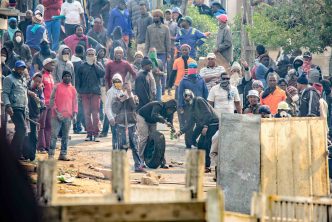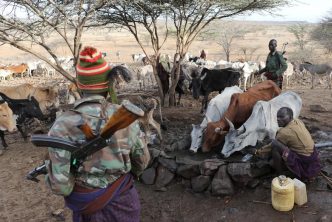Improving humanitarian response in Nigeria
By Dr. Oarhe Osumah
The availability and accuracy of data have continuously determined the effectiveness of humanitarian intervention in Nigeria.
Introduction
The activities of the insurgent group and those of the counterinsurgency forces have resulted in massive displacement, insecurity, destruction of properties, and the collapse of essential services in several areas of the sprawling Northeast region of Nigeria. These humanitarian tragedies have elicited interventions from both government and non-government organisations. These organisations have provided life-saving assistance and helped to stabilize living conditions for millions of people. Although the humanitarian responses have been huge, they appear not to have been adequate (Nwakpu and Ogbodo, 2018). This edition of Nextier SPD Policy Weekly highlights the daunting challenges of data management for humanitarian interventions in the Boko Haram-ravaged North-East region of Nigeria.
Data Troubles
Like the Taliban in Afghanistan, in 2012, suspected Boko Haram militants destroyed 150 telecom infrastructure/stations in communities in Northern Nigeria, leading to massive network outages and poor communication service delivery. This situation also impaired internet service used to facilitate action (Onuoha, 2013). These disruptive effects cascaded through the entire society affecting banking services and diluting the efficiency of specific humanitarian initiatives such as the unconditional cash transfer scheme.
Apart from the disruption of facilities for gaining data necessary for humanitarian interventions, the fluidity of data on the number of Internally Displaced Persons (IDPs) and the patterns of their displacement are also a disturbing factor in humanitarian action. While there exist various records of the IDPs, these data aren’t comprehensive. In the absence of a comprehensive register for all IDPs, several organizations have made various estimates. The National Emergency Management Agency (NEMA) and the Nigeria Police Force in April 2016 noted that 1,934,765 IDPs were living in formal camps, host communities, and satellite camps in the North-Eastern states of Borno Bauchi, Gombe, Adamawa, Taraba, and Yobe (Sambo, 2017). Some IDPs in the official camps refused to register for fear of stigma or believe it is futile. Added to this, some of the government-run camps have suffered attacks. These various attacks from both friendlies and foes have forced some IDPs to flee the official camps and take shelter with their relatives and friends in neighboring communities. Indeed, a more significant proportion of the IDPs put at 92{1c02100822988c48c7b0a484ab61ac3d7f398d67c2f66594d88b2db33072d9d9} take refuge outside the official camps for other reasons. Many prefer to remain invisible as a self-surviving mechanism despite overwhelming needs and traumatic experiences. It means their needs are often forgotten or easily overlooked, even in the official camps.
The Displacement Tracking Matrix developed by the International Organization for Migration (IOM) estimated 389,281 displaced persons in 2013; 863,338 in 2014; 1,846,999 in 2015; 1,822,541 as at October 2016; and 1,884,331 in the North-East zone as of April 30, 2017. These diverse and mutating estimates can overwhelm and frustrate humanitarian aid workers. The fluidity of the number of IDPs and the lack of a comprehensive register of the people in need of assistance make it challenging for humanitarian agencies to make informed decisions to facilitate the provision of humanitarian aid where it is needed.
More disturbing for humanitarian intervention is the umbrella estimates of the displaced persons without disaggregation in terms of specific parameters such as those trapped in the communities, homed in IDP camps, sheltered by relatives, relocated to other places, returnees, etc. This makes it challenging to tailor humanitarian intervention programmes to local needs and focus on cross-cutting issues such as education, health, and protection.
Similarly, the politicization of figures by stakeholders such as the government, international bodies, and Boko Haram also impair humanitarian intervention. A recent report on the killing of rice farmers in Koshobe village of Borno State buttresses this point. While the Nigerian government put the casualty figures at 43 conceivably to justify its claim to have technically defeated the BH group, the insurgents put the figure at 73 probably as a propaganda tactic. Simultaneously, the UN humanitarian coordinator in Nigeria, Edward Kallon, placed the figure at 110, possibly to attract global attention to the massacre.
Similarly, an allegation of corruption of data by IDP camp managers through inflation of the number of inmates to possibly attract substantial financial support or allocation also indicates a data crisis for humanitarian intervention. With conflicting and corrupt data, aid workers cannot be sure about the scope of the humanitarian concerns and the needs of the people affected, and how to prepare proper responses. Simultaneously, ascertaining the integrity of these data will not only demand so many energies and resources from humanitarian organizations, but it will also slow down action and stoke tension. The task of verification of data may overstretch them beyond their core mandate and engender fatigue. There is also the risk of being bias if a humanitarian organization relies on anyone stakeholder’s data. Such action negates the expected neutrality and independence stand of these organizations.
Guide to Addressing the Data Troubles
In addressing the data crisis in conflict zones of Nigeria, these policy measures are imperative.
1. Reconstruction of telecommunication facilities: The Nigerian Communications Commission should assist telecommunication companies by providing interest-free loan facilities to reconstruct and upgrade their telecommunication facilities damaged by suspected Boko Haram militants. It will help to facilitate access to the internet for more people in the region. Apart from promoting more effective humanitarian and emergency service delivery, this gesture can also enable the people to report security threats on time to avert wanton destruction of facilities and loss of lives.
2. Need for Humanitarian partnership: Humanitarian partners need to strengthen their data management processes by developing better tools and carrying out more frequent monitoring and assessments in prioritized areas. Iraq adopted the humanitarian partnership approach to address the dynamic, complex, and shifting needs of the vulnerable population amid the transition from a rapid response to massive displacement to a protracted crisis in search of durable solutions. The joint initiative between NEMA and the UN on the Displacement Tracking Matrix has led to better data and displacement analysis and should be sustained.
3. Sharing of information: The personnel (journalists, humanitarian officers, and security agents) who work in these conflict zones should share information at their disposal. This will improve data management in these areas. One way to get around this is to create a semi-public central database populated by all relevant stakeholders.
4. Monitoring of the humanitarian situation and needs: It is imperative to create and maintain monitoring systems and mechanisms for continuous review and assessment of the situation in hard-to-reach areas adopted in countries such as Afghanistan and Iraq.
Conclusion
In North-East Nigeria, the ongoing Boko Haram insurgency and counterinsurgency operations, which have lasted for more than a decade, have engendered humanitarian situations and data crises. The data crisis stems from damage to telecom infrastructure, corruption, and politicization by critical stakeholders. The data crisis has disruptive consequences for humanitarian interventions. It is imperative to undertake policy measures such as the rebuilding of telecommunication facilities, the need for humanitarian partnership, and strengthening monitoring systems for tracking the humanitarian situation to address the data crisis.







